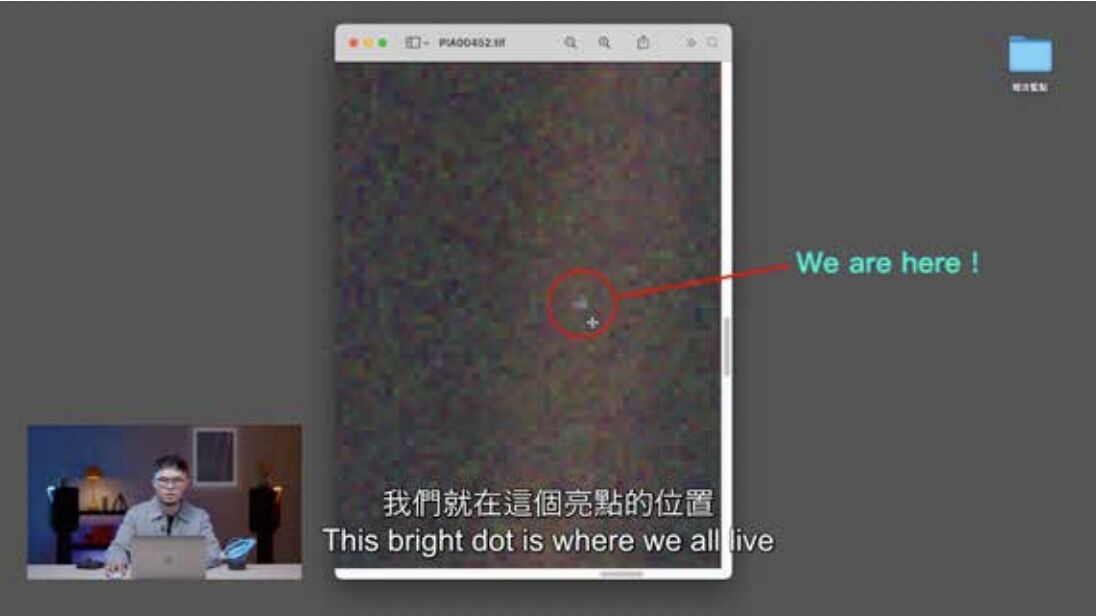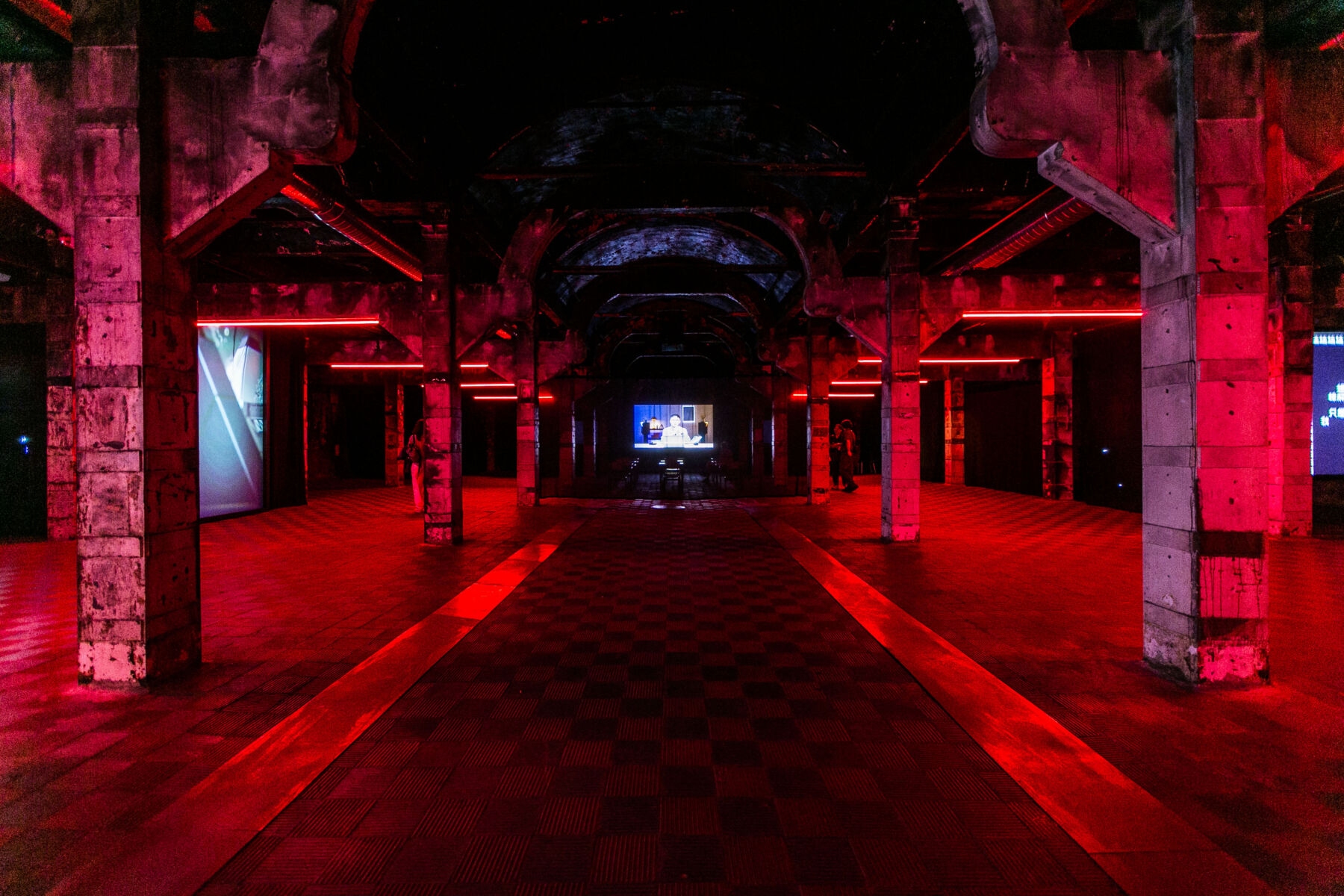Text by Meritxell Rosell

In a striking exploration of digital aesthetics, the Taiwanese art collective Simple Noodle Art delves into the intricate world of pixels with their video installation, How To Improve Photo Quality by AI | Noise Reduction, Super-resolution Tutorial. This immersive piece unravels the complexities of image enhancement through artificial intelligence, highlighting both the technological advancements and the inherent tensions within digital creation.
The installation was presented as part of The PIXEL GODS exhibition at LE.V. Matadero last September. The Taiwan Digital exhibition started as part of Focus Taiwan, a long-term collaboration between the Economic and Cultural Taipei’s Trade Office in Spain and L.E.V. due to a shared and everlasting interest in contemporary digital creation in Taiwan.
This year, L.E.V. Matadero created an exhibition to display the vibrant diversity of today’s Taiwanese artworks, elaborating on one of their most defining elements: audiovisual creation using technological resources and the transformations these art developments have experienced. The focus was on the essential element of digital image: the pixel.
As the fundamental building blocks of digital imagery, each pixel, a minuscule unit of colour, forms the fabric of our visual experience. Yet, as Simple Noodle Art demonstrate, the quest for higher resolution often grapples with the paradox of noise: the unwanted artefacts that can distort clarity and undermine the integrity of a digital image. Through a captivating blend of tutorial and artistic commentary, the collective invites viewers to consider how AI can serve as both a tool for enhancement and a source of new creative expression.
Founded in 2019 by Chen Zi-Yin and Chuang Hsiang-Feng, Simple Noodle Art is an art collective that works with installation, video, net art, photography, and artificial intelligence. With backgrounds in art and information technology, respectively, Chen and Chuang focus on the interactions between technological products and humans and how such interactions alter and influence our lifestyles.
For the installation, the artist adopts the form of a software tutorial often used by self-media and utilises the astronomical image Pale Blue Dot as a sample. Using the Al functions of noise reduction and super-resolution, the noise-like Earth is removed to extend a “pale blue dot in high quality,” which enables the artist to imagine how Al perceives their puniness.
Dynamic visuals showcase noise reduction and super-resolution techniques. As viewers navigate the crated landscape, they are prompted to reflect on the implications of AI in the realm of photography and visual culture. The art collective adeptly juxtaposes the mechanical precision of algorithms with the organic nature of human perception, raising questions about authorship, authenticity, and the evolving role of technology in our lives.

The artists share they have always been fascinated by the ‘Pale Blue Dot’ photograph. From a place so distant, almost at the solar system’s edge, looking back at the Earth, we realise that our planet is just a tiny blue dot, almost like noise. The astronomer Carl Sagan’s poetic and thought-provoking words remind us that this little pale blue dot challenges humanity’s illusion of privilege. On the scale of the universe, we appear so small and absurd while simultaneously revealing how human senses, through scientific imaging, have extended their reach across vast distances, they mention.
In digital photography, the post-processing workflow involves noise reduction and enlargement to achieve high enough quality for printing and display. In the past, these methods were rule-based primarily, using some deterministic mathematical models for processing. However, in recent years, AI technology has opened a new chapter in photo quality optimisation. AI has significantly improved noise reduction and image super-resolution performance by learning from large datasets of noisy and denoised images or pairs of images with different resolutions. A large amount of training data can minimise the impact of exceptions on the AI model, thereby improving the model’s adaptability (robustness). Yet, despite the logic behind training such a reasonable AI noise reduction model, it perceives Earth in the ‘Pale Blue Dot’ as noise, removing it along with other noise. And the 12 additional pixels generated by the AI super-resolution model—are they built on a universe without Earth, without us?
In a broader context, How To Improve Photo Quality by AI serves as a commentary on our obsession with visual perfection in the age of social media, where every pixel is scrutinised and curated. Simple Noodle Art’s work challenges this pursuit, urging us to embrace the imperfections that accompany the digital age. By showcasing the potential of AI to enhance images while simultaneously acknowledging its limitations, the installation cultivates a nuanced dialogue about the future of visual artistry.
How can we understand what AI is thinking? They ask. This has been a highly popular question in recent years. The cosmological perspective expressed in this work, or the one it seeks to explore, reflects a vision of a future where AI becomes increasingly integrated into our lives. There is no perfect model in this world, which means we will always find flaws in AI, but we will have to live with these flaws in the future. For them, This is not a critique of AI. Instead, should we consider that we already live with imperfections? Life without AI has its flaws, too, and perhaps even more so. We brought AI into our lives for this reason. Humanity is small about the universe and also with AI. Yet, we must remain vigilant about the flaws that will always exist— even if they become fewer and less visible, like noise.
The fact that the work is presented as a tutorial makes us reflect on the relationship between technology and meaning. In our growing years, most of our learning relied on traditional methods like schools and books, the artists comment. Now, with the rapid development of communication technologies, multimedia and audiovisual content delivered through streaming media has captured people’s attention. Various types of self-media (also known as we media) have pushed the privatisation of images, especially those considered ‘poor images,’ even further toward the privatisation and democratisation of image content creation. Among these, tutorial videos have become one of our primary learning tools. The field of learning is no longer confined to schools or institutions, making technologies like AI, which were once challenging to self-learn, more accessible. Although I may not have the computational power, data, or research staff that big tech companies possess, cutting-edge technologies are now within reach. Simply using these technologies allows us to teach others how to use them; they also mention.

When asked how they see AI reshaping not just visual art but also our broader perceptions of self and space, they continue by saying that in the past, we always used the Turing test to determine whether AI possesses intelligence comparable to that of humans. In recent years, some people believe that AI has already passed the Turing test or even surpassed its originally set goals. And yet, we still feel that AI isn’t good enough, don’t we? We believe that it’s not really about testing AI; it’s about testing humans. What AI reveals is the mechanical aspect of existence. Through AI, we realise how much mechanicality was present in what we once considered our creativity. We don’t believe that AI will completely replace creativity. Instead, AI will help us execute the mechanical parts of tasks quickly and cheaply. The artists conclude that this may allow humans to focus more on things that mechanical processes cannot accomplish.
Ultimately, Simple Noodle Art’s video installation is not merely a tutorial on improving photo quality but a profound meditation on the relationship between technology and creativity. By illuminating the pixel as a site of both beauty and complexity, the collective invites us to reconsider how we engage with images in an increasingly digital world—where every pixel tells a story, and every story is a pixel in the vast tapestry of visual culture.






